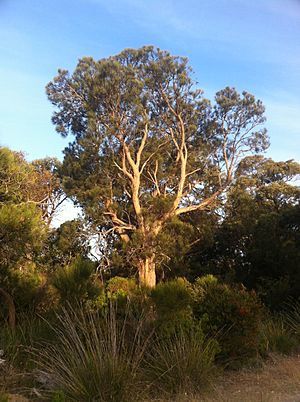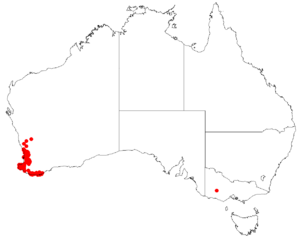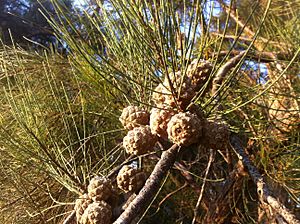Western sheoak facts for kids
Quick facts for kids Western sheoak |
|
|---|---|
 |
|
| A. fraseriana in Albany | |
| Scientific classification | |
| Genus: |
Allocasuarina
|
| Species: |
fraseriana
|
 |
|
| Occurrence data from AVH | |
The Western Sheoak (Allocasuarina fraseriana) is a special type of tree. People also call it the common sheoak or Fraser's sheoak. It belongs to the Casuarinaceae family.
This tree only grows in Western Australia. You can find it near the coast in the southwest part of the state. It grows from Jurien in the north to Albany in the south. The Noongar people, who are the traditional owners of this land, call this tree Condil, Kulli, or Gulli.
Contents
What the Western Sheoak Looks Like
The Western Sheoak can grow quite tall, up to about 15 metres (50 feet) high. This happens when it has good growing conditions. But if it's near the coast where salty winds blow, it usually stays smaller. The main trunk can be about 0.5 to 1 metre (1.6 to 3.3 feet) wide.
This tree doesn't have wide, flat leaves like many other trees. Instead, it has thin, green branches that look like needles. These are called cladodes. The real leaves are tiny and look like small teeth. They are found around each joint on the cladodes.
Flowers and Fruit
Male Western Sheoak trees have small, brown flower spikes. These grow at the ends of their needle-like branches. When they flower in late winter and early spring, the male trees look rusty brown because of all the flowers.
Female trees have small flowers too, but they grow on shorter branches. After these flowers are pollinated, they turn into egg-shaped cones. These cones are about 1.5 to 3.5 centimetres (0.6 to 1.4 inches) across.
Where the Western Sheoak Grows
Most Western Sheoak trees are found in the South West and Great Southern areas of Western Australia. Some smaller groups of trees grow between Jurien and Moora.
You can find this tree growing in different types of soil. In the Darling Range, it grows in reddish-brown soils under Eucalyptus marginata forests. Near the coast, it prefers sandy soils in woodlands and open forests.
History of the Western Sheoak
The Western Sheoak was first collected in 1840 by a person named Johann Preiss. The tree's scientific name, fraseriana, was given to honor a botanist named Charles Fraser.
The tree was first officially described in 1848 by Friedrich Anton Wilhelm Miquel. He called it Casuarina fraseriana. Later, in 1982, Lawrence Alexander Sidney Johnson moved it into the Allocasuarina group of trees.
Uses of the Western Sheoak
The Western Sheoak has been very useful to people and animals.
Uses by People
The Noongar women traditionally used the soft, fallen needles of the Western Sheoak. They would give birth under these trees. The needles were also used as soft bedding inside shelters. Sometimes, they would cover the needles with a kangaroo skin cloak to make a warm bed.
Early European settlers in Western Australia also found uses for the sheoak wood. They used its timber to make roof shingles for their homes. Later, the wood was used to build kegs and casks for liquids.
Today, the wood is still valued, especially for its unique patterns. People use it for wood-turning and carving beautiful decorations. The outer part of the wood is a pale yellow, while the inner part is a dark red to brown. It has a fine and even texture.
Uses by Animals
The seeds from the Western Sheoak cones are a favorite food for red-eared firetails (Stagonopleura oculata). These small birds are a type of grass finch and are only found in Australia.
See also
 In Spanish: Roble hembra del oeste para niños
In Spanish: Roble hembra del oeste para niños




